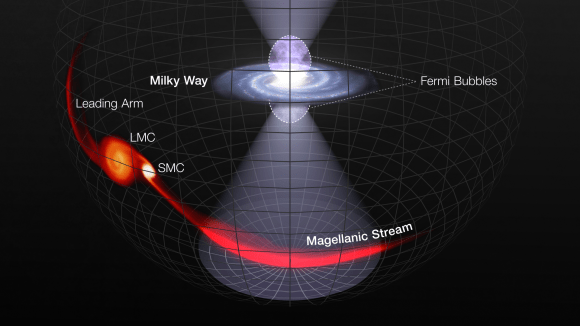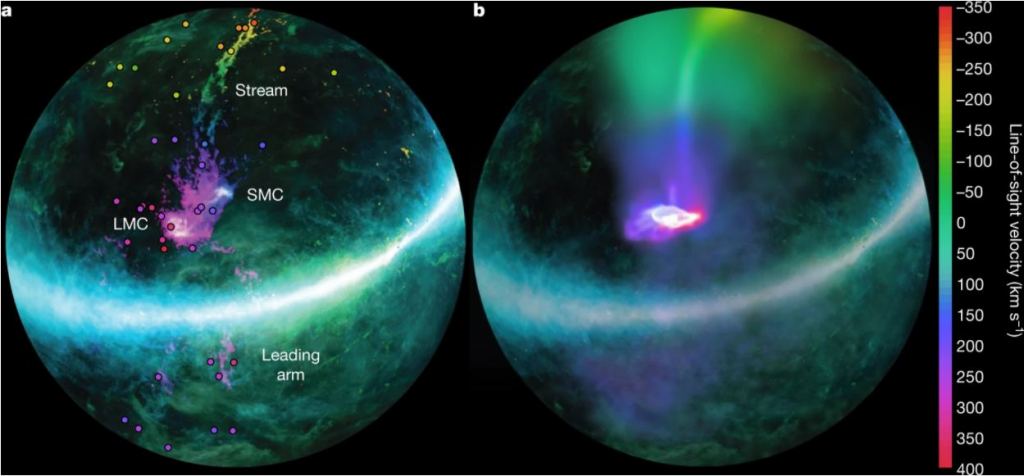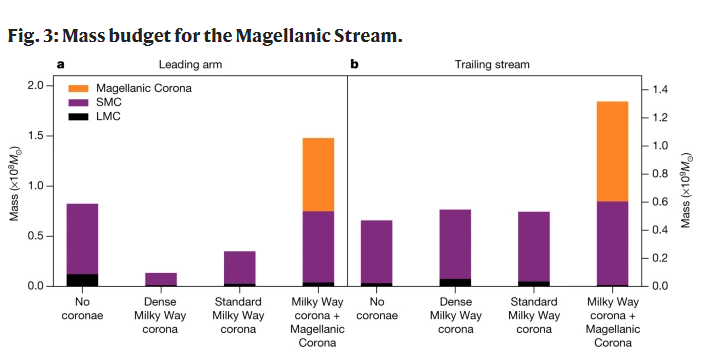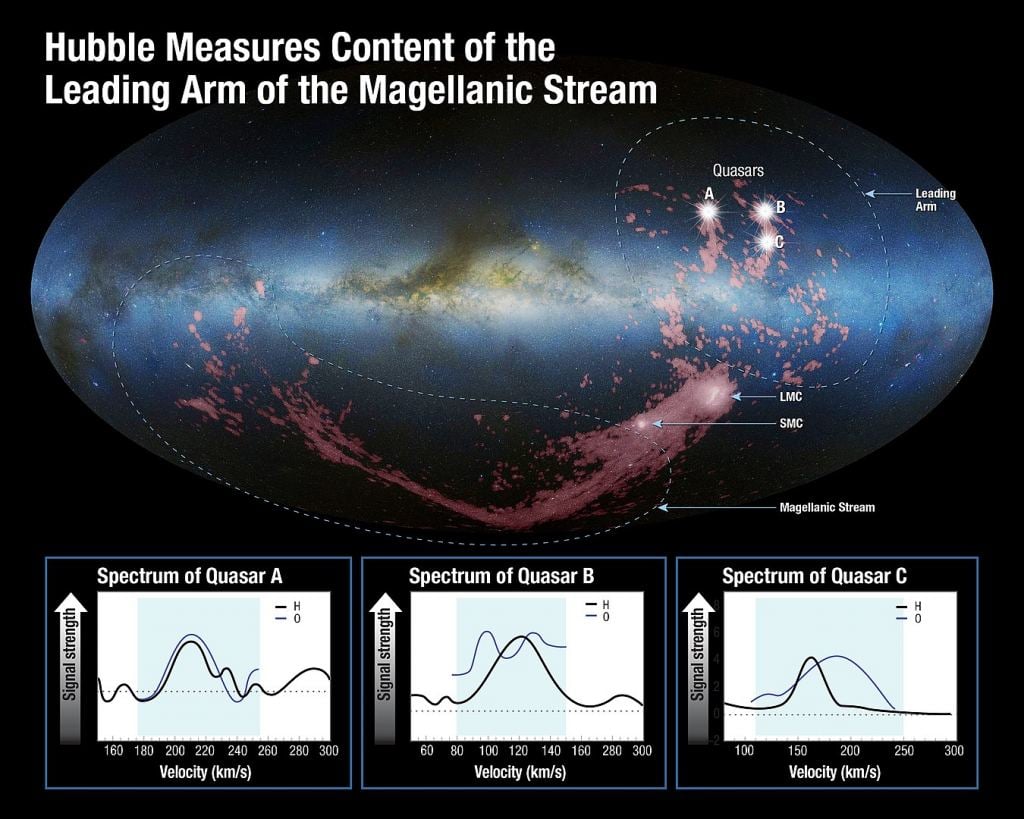Massive galaxies like our Milky Way gain mass by absorbing smaller galaxies. The Large Magellanic Cloud and the Small Magellanic Cloud are irregular dwarf galaxies that are gravitationally bound to the Milky Way. Both the clouds are distorted by the Milky Way's gravity, and astronomers think that the Milky Way is in the process of digesting both galaxies.
A new study says that process is already happening, and that the Milky Way is enjoying the Magellanic Clouds' halos of gas as an appetizer, creating a feature called the Magellanic Stream as it eats. It also explains a 50 year old mystery: Why is the Magellanic Stream so massive?
The Magellanic Clouds have been orbiting the Milky Way for billions of years. That interaction has created a massive stream of gas called the Magellanic Stream, the dominant gaseous structure in the Milky Way, to stretch across the sky from the Clouds to the Milky Way. We can't see it with our naked eyes, but it's there.
But scientists have struggled to answer an important question about this stream: Why is it so massive?
"The stream is a 50-year puzzle." Andrew Fox, Co-Author, Astronomer at STScI
A team of scientists think they have the answer. They're presenting their work in a new paper titled " The Magellanic Corona as the key to the formation of the Magellanic Stream." It's published in the journal Nature, and the lead author is Scott Lucchini, a graduate student in the UW–Madison physics department.
The Magellanic Stream is a cloud of high velocity gas that stretches across the sky. It extends further than 100 degrees, from the Large and Small Magellanic Clouds through the Milky Way's south pole. It was first seen in 1965, and its velocity patterns were different than the Milky Way's. At first, scientists didn't realize that it even had any connection to the Magellanic Clouds. Researchers thought it was just a high velocity gas cloud. High velocity gas clouds are common in the Milky Way's halo, and in fact the Magellanic Stream can be thought of as a collection of these clouds.
A central question around the Magellanic Stream concerns its mass. It's over a billion times more massive than the Sun, and astronomers have been unable to figure out why.
"The existing models of the formation of the Magellanic Stream are outdated because they can't account for its mass," says Scott Lucchini, a graduate student in the UW–Madison physics department, first author of the paper.
"That's why we came out with a new solution that is excellent at explaining the mass of the stream, which is the most urgent question to solve," adds Elena D’Onghia, a professor of astronomy at UW–Madison who supervised the research.
Older astronomical models showed that the Magellanic Stream is a result of gravitational tides, and of the pushing and pulling of the galaxies. As the Magellanic Clouds got closer to the Milky Way and began orbiting, gravity pulled material directly from the Large and Small Clouds to form the Stream. As the authors write in their paper, "Although it has long been suspected that tidal forces and ram-pressure stripping contributed to the formation of the Magellanic Stream, models have not been able to provide a full understanding of its origins."
Older models assumed that the gas in the Stream came mostly from the Small Magellanic Cloud, because that cloud didn't have enough gravity to retain its gas. Those models were partly successful, in that they predicted the size and shape of the Magellanic Stream. But they couldn't account for the mass, and could only explain one tenth of the mass of the Stream. They also couldn't explain the fragmented structure of the Stream, and why gas from both Clouds was present in the Stream.
Here's where galactic halos come in.
Astronomers have known about galactic halos for a while now. A galaxy like the Milky Way has a massive halo that extends far beyond its spiral shape. The halo has three components: the stellar halo; the gas corona; and the dark matter halo. This work concerns the gas corona, also called the gas halo.
What astronomers didn't realize is that the Magellanic Clouds were large enough to have their own gas halos. That is a recent discovery, and the older models predate that knowledge. For D'Onghia and her team, that made the difference. They realized that the presence of these halos would dramatically alter how the Magellanic Stream formed.
Lead author Scott Lucchini performed some new computer simulations of the Magellanic Stream. He divided the creation of the Stream into two periods.
In the first period, the Large and Small Magellanic Clouds are far away from the Milky Way, but moving through space together. During that time, the LMC is drawing gas away from the SMC over billions of years. That stolen gas would later make up between 10% and 20% of the Magellanic Stream.
Then came the second period of time, when the Clouds were closer to the Milky Way and began to orbit it. During that time, the Milky Way began to draw material from the gas corona of the Clouds, creating the enormous arc of the Magellanic Stream.
"This work redefines our understanding of how gas accretes onto the Milky Way and forms the reservoir for future star formation." Co-Author Joss Bland-Hawthorn, Director, Sydney Institute for Astronomy.
This new model does a much better job of explaining the Magellanic Stream's mass. But it goes even further. It does a better job of explaining the Stream's filament-like shape, and shows how the Stream is mostly made up of the more energetic ionized gas, rather than non-ionized.
Maybe even more importantly, it explains the lack of stars in the Stream. Since the material that makes up the Stream is from the gas corona rather than the main body of the Magellanic Clouds themselves, there are no stars. These simulation results also agree with some previous research, showing that the material in the Magellanic Stream's Leading Arm is predominantly from the Small Magellanic Cloud. That material would have been taken from the SMC by the LMC in the first phase, and then into the Leading Arm.
"The stream is a 50-year puzzle," says Andrew Fox, one of the co-authors of the study and an astronomer at the Space Telescope Science Institute, which operates the Hubble Space Telescope. "We never had a good explanation of where it came from. What's really exciting is that we're closing in on an explanation now."
The work doesn't end here, though. Now that simulations have arrived at a possible explanation for the mass of the Magellanic Stream, it can be tested observationally. If there is a corona of gas surrounding the Magellanic Clouds, the Hubble Space Telescope should be able to see the telltale signs of it. It'll do that by observing UV light from background quasars.
"The Magellanic Corona will be unambiguously observable via absorption in highly ionized states of carbon and silicon (C IV and Si IV) in the ultraviolet spectra of background quasars lying near the LMC on the sky," the authors write in their paper. They add that "...background-quasar sightlines offer the chance for unambiguous detections of the Magellanic Corona, because they are uncontaminated by the LMC's interstellar material."
In fact, some observations have already hinted at the presence of a corona surrounding the Clouds. With a more clear-cut idea of what to look for to test the corona's existence, we should get a more complete picture of the Milky Way and its galactic surroundings in the near future.
"This work redefines our understanding of how gas accretes onto the Milky Way and forms the reservoir for future star formation," says Joss Bland-Hawthorn, a co-author of the paper and director of the Sydney Institute for Astronomy in Australia.
More:
- Press Release: Massive halo finally explains stream of gas swirling around the Milky Way
- New Research: The Magellanic Corona as the key to the formation of the Magellanic Stream
- Universe Today: About 3.5 Million Years Ago, a Stream of Gas Outside the Milky Way Would Have Lit Up the Night Sky
- Universe Today: Enjoy The Biggest Infrared Image Ever Taken Of The Small Magellanic Cloud Without All That Pesky Dust In The Way
 Universe Today
Universe Today





